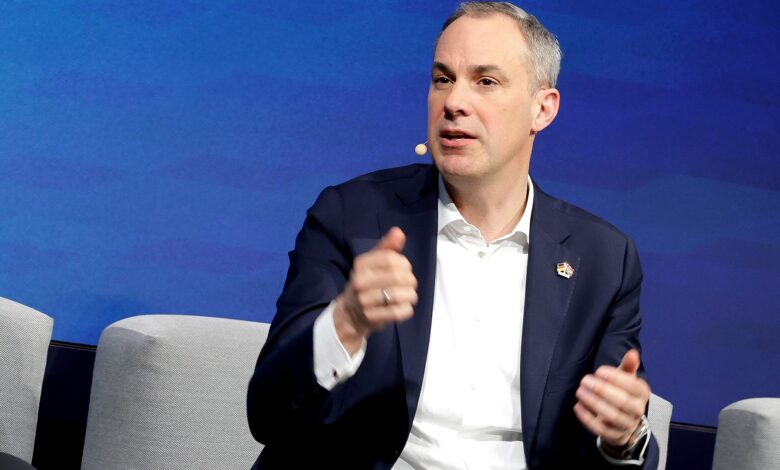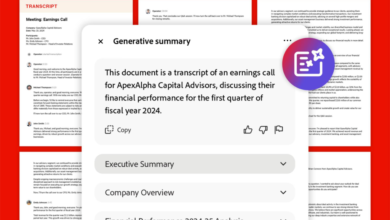‘Every tech is hyped, but this is different’ – Siemens goes all-in on industrial AI

There’s something funny about a captain of industry (Industrie 4.0) scratching his head when his boiler breaks down at his French summer house. But this was the tale that Cedrik Neike, chief executive at Siemens Digital Industries, told Hannover Messe on Monday (April 22) to illustrate the power of generative AI in the industrial space. The point was that, having phoned for help, there was a communication breakdown as a French boiler man attempted to make sense of a German boiler manual. Neike, a Franco-German, played the AI, and translated for the plumber.
The message from Siemens at Hannover Messe is that generative AI is the industrial revolution, and that this kind of multilingual error-code nonsense never needs to happen again on the factory floor. More than this, of course, all that rarefied engineering knowhow – acquired over decades in manufacturing environments, and headed for retirement, or else studied at PhD-level in elite technical colleges, and hard to find and expensive to hire – can now be recorded in software, and made instructional and interactive so that low-paid college leavers can fill their big work boots.
And so the captains of industry can get on with their cheese boards. That’s mean; but you get the idea. Hannover Messe is a gargantuan industrial fair in the middle of nowhere. (Hanover is sleepy, and expensive, compared to most trade-fair towns.) It is where every over-hyped technology comes to live and die, and then, in most cases, to be resurrected as distinctly innovative and cumulatively useful digital solutions to optimise industrial processes. Siemens said this on Monday of 3D printing, IoT, and digital twins, which, after hype and gloom, are all now vital to industry.
It might say the same of 5G. But it does not say the same of generative AI. The hype curve will not flatten, it implied. Honestly, coming here, filled with stories about the early-stage horrors of AI hallucination, and convinced the same issues of quality and access (garbage in / out) will apply, I was a little sceptical. But the big boys are all-in. Perhaps Hannover Messe is not the place to look for the truth of it, but when a juggernaut firm with 60 percent of the industrial automation market says, with such earnest zeal, that the AI hype is real, then… it is probably worth reporting at least.
Here’s an extended (and edited) sample of the press-conference pitch from Neike. He pointed to a slide with an image of a Babelfish from The Hitchhiker’s Guide to the Galaxy, and then to a slide of some early-1970s ChatGPT forbear that Siemens dreamed up in a lab, and he tracked back and forth between science fiction and science reality, and made the case that Siemens has done its part to join the dots. He addressed a packed house, at the biggest booth at the biggest industrial showcase in the world; it went like this…
“Any geeks in here? Do you know what this is (gestures to slide)? It’s a Babelfish, right? From Hitchhikers’ Guide to the Galaxy. You put the fish in your ear and it translates instantaneously – so you can speak all the languages of the universe. This was science fiction. But science fiction is coming true… AI is incredibly, incredibly powerful – especially generative AI. It will transform our industry. Why? Because we have an ageing population; 2022 was the first year that more people left the G7 workforce than entered it. Supply chains are more and more globalised, as well. And we need to address the climate change issue. We need to move much faster.
“Generative AI could supercharge [all of this] going forward. But generative AI needs to be different in the industrial space. It needs to be 100 percent secure. We cannot afford any hallucination. When you build a power plant or a chemical plant, or when you develop a new drug, you need to understand how [the AI comes] to its conclusion. AI for industry is all about making AI predictable and secure. Which is where Siemens comes in. We make AI real, we make AI industrial, and we make industrial AI easy. But there’s nothing new about AI. Lots of the models were embedded 30 or 40 years ago. We have taken [all that time] to make AI robust, reliable, transparent.
“This (gestures to a new slide) is 1974. There’s a central research department in Siemens which had the task to develop an interactive automatic natural-language question-and-answer system. In ways, it was like ChatGPT’s grandma. So Siemens has been working on AI for a long time. We have 1,500 AI experts in Siemens. Research by a UK headhunter firm says Siemens is the number [employer] for industrial AI researchers. We have more than 2,800 patents – three times as many as our competitors in the industrial space… We have a lot of knowledge [and research about]… how machine learning processes can communicate how they arrive at their decision.
“Because AI is a black box, which needs to be made transparent. Siemens is deeply rooted in understanding AI in an industrial context. We understand the guardrails, and how it should be secured. We understand how to make it useful. And we want to accelerate it faster and faster… But how do you go from theory to practice, and [then] to scale? We have 30 years of theory – of AI development, ML models, neuro-language models. And we are now putting that into practice. Today, at this press conference, I am talking about how to make AI orderable.”
Siemens’ big AI launch at Hannover Messe was covered last week, actually, with news that an AI tool, called Industrial Copilot, will be commercially available on the company’s Xcelerator Marketplace this summer (for free, for a time, it turns out), plus of developing partnerships with the likes of AWS, Microsoft, NVIDIA, and German industrial equipment manufacturer Schaeffler Group. Most of the rest of the press conference on Monday was about this, but there was good detail and commentary besides, which RCR Wireless will attempt to revisit. The point is that Siemens is plugging generative AI into a whole series of connected worker and connected machine apps.
“We are on a journey. Let’s be clear. But AI is an overnight sensation, which was 30 years in the making. Because for 30 years, we’ve prepared all of the AI elements – which we are now putting into the industrial space to make sure it works. A lot of it sounds like sci-fi, but it’s real. There is a hype curve for every new technology. But this works, and this makes a huge, huge difference. And because there are fewer engineers and fewer factory workers, and because we need to move to higher capabilities, we are putting AI into action now. And you can see it everywhere. I mean, you want to talk about semiconductors, or automotive, or food and beverage? It is there [already].”
Emotive stuff. Final thought; Siemens has an influential position not just because of all the logic controllers, and others bits of industrial hardware, it has already deployed in factories around the world, but because its Teamcenter product lifecycle management (PLM) system, which connects people and processes across functional enterprises silos, and works as the platform for its whole digital twin (industrial metaverse) shtick. Teamcenter pulls in data from enterprises, and has done for donkeys’ years. It is the number one PLM platform in the OT market, it reckons.
The point, here, is this garbage in / out issue is negated, to an extent – or at least reduced. Siemens said at Hannover Messe that it has a clever way (called “retrieval augmented generation”) to make sure that private data is never compromised in the process. But Teamcenter gives Siemens an edge, it contends. The explanation also throws up another truism, which came out of Hannover Messe – which impacts the 5G crowd, suffering a little but in Germany, out in hall 14 (just as it does the IoT and edge contingents as well).
Because until now they have sold a big fat pipe to enterprises, which, when deployed and actually connected to 5G end-devices, has been able to chuck masses of data into the edge-cloud – where it has mostly just sat, as a workload too-large for any human-powered analytics software. But AI, generative or not, will provide the means to make sense of it for the first time – and a reason to buy these fat 5G pipes in the first place. After 15 years of talking about Industry 4.0, it is like all of the building blocks are in place. It felt like that at Hannover Messe this week, anyway.
But maybe the beer and the bratwurst have made me soft.



